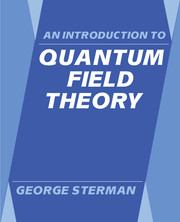Book contents
- Frontmatter
- Contents
- Preface
- PART I SCALAR FIELDS
- PART II FIELDS WITH SPIN
- PART III RENORMALIZATION
- PART IV THE NATURE OF PERTURBATIVE CROSS SECTIONS
- 12 Perturbative corrections and the infrared problem
- 13 Analytic structure and infrared finiteness
- 14 Factorization and evolution in high-energy scattering
- 15 Epilogue: Bound states and the limitations of perturbation theory
- APPENDICES
- References
- Index
13 - Analytic structure and infrared finiteness
Published online by Cambridge University Press: 05 August 2012
- Frontmatter
- Contents
- Preface
- PART I SCALAR FIELDS
- PART II FIELDS WITH SPIN
- PART III RENORMALIZATION
- PART IV THE NATURE OF PERTURBATIVE CROSS SECTIONS
- 12 Perturbative corrections and the infrared problem
- 13 Analytic structure and infrared finiteness
- 14 Factorization and evolution in high-energy scattering
- 15 Epilogue: Bound states and the limitations of perturbation theory
- APPENDICES
- References
- Index
Summary
The zero-mass limit is intimately related to high-energy behavior in field theory. As we have seen in Section 12.4, cross sections develop collinear, as well as infrared, divergences as masses vanish. These divergences, however, cancel in certain perturbative quantities, jet cross sections in e+e− annihilation among them. Proofs of finiteness for these and other ‘infrared safe’ quantities require a formalism to treat infrared and collinear divergences to all orders in perturbation theory. Such a formalism can be developed on the basis of the analytic structure of Feynman diagrams, which we shall supplement by a power-counting method for estimating the strength of singularities in massless perturbation theory. We shall use these tools to prove a number of important results, including the infrared finiteness of Wick-rotated Green functions and of the e+e− total cross section, as well as of e+e− jet cross sections. The finiteness of the latter, in turn, is a variant of the famous KLN theorem, which states that suitably averaged transition probabilities are finite in the zero-mass limit for any unitary theory.
Analytic structure of Feynman diagrams
The calculations of Section 12.5 are suggestive and encouraging, but we must still determine whether jet cross sections are really mass-independent at higher orders in perturbation theory.
- Type
- Chapter
- Information
- An Introduction to Quantum Field Theory , pp. 411 - 448Publisher: Cambridge University PressPrint publication year: 1993



